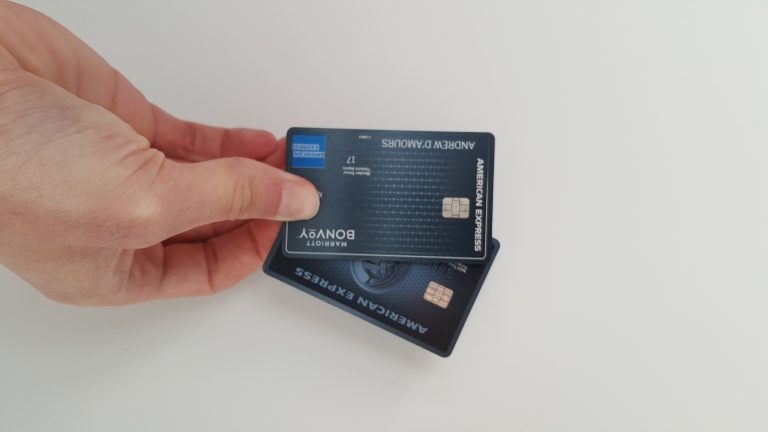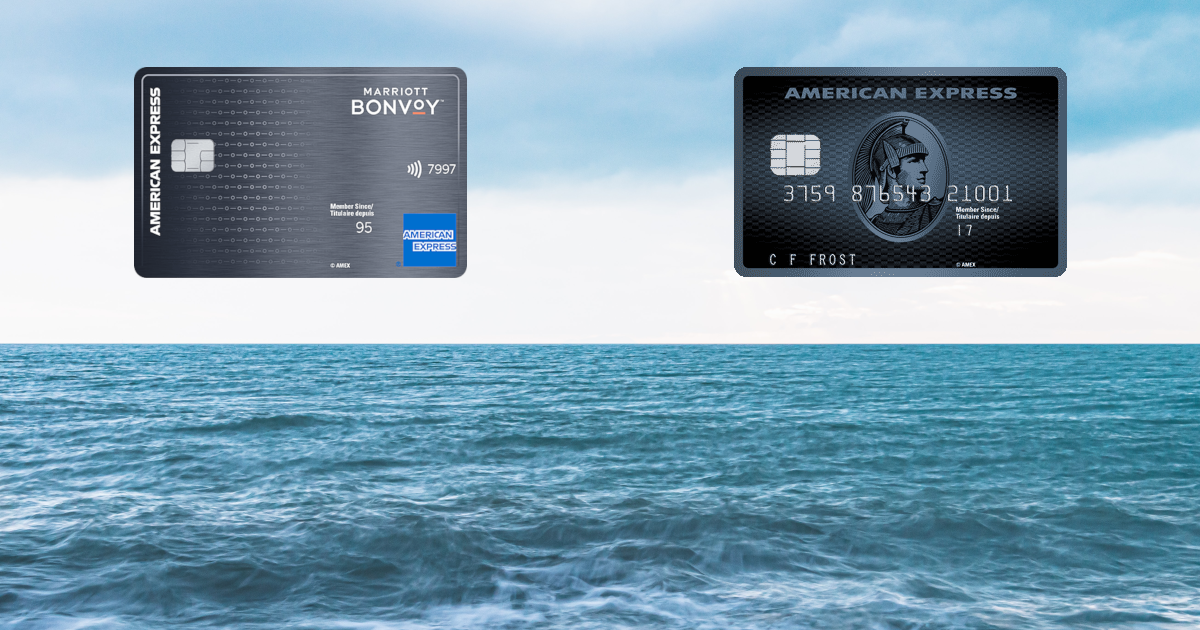Canadians who want to maximize the value they get from their rewards know that Marriott points are among the best—if not the best—thanks to their potential for outsized value and unlimited value. And Marriott points are so easy to earn, especially right now with one of the cards having its highest-ever welcome bonus offer that offers tens of thousands of points. Since many have asked us how to choose between the 2 cards, here is our comparison.
After unlocking the welcome bonus, you will get:
- 73,000 Marriott points with the Marriott Bonvoy American Express Card
- 105,000 Marriott points with the American Express Cobalt Card
That’s enough for 11 completely free nights (or 16 for the Cobalt) in some amazing destinations, like in beautiful Bali or in a few other countries (and that’s for a solo rewards enthusiast; if you are in two-player mode, you can double that of course). You can also get 6 free nights (or 10 with the Cobalt) in even more destinations if you prefer having more options. And the points won’t expire.
But the cards have major differences, especially with the spending level required to unlock the welcome bonus.
Here is our guide to help you choose which one is the best for you now.
Deciding which of the 2 cards to get
They are both among the best credit cards in Canada even without considering the current increased welcome bonus (or even without considering welcome bonuses at all).
As we’ve said before, the Marriott Bonvoy American Express Card is a card all Canadian travelers should definitely have. You can read our detailed review of the Marriott Bonvoy American Express Card if you want to know why.
But on the other hand, while the American Express Cobalt Card is not for everyone, even if it is usually considered literally the best card in Canada.
Travel rewards pros should have both of them for sure. We certainly do ourselves.
So the true question is really: is the American Express Cobalt Card right for you?
- If the answer is yes: then you need to decide which one of the 2 you should get first
- If the answer is no: get the Marriott Bonvoy American Express Card with its current increased welcome bonus (unknown end date)
We’ll compare both cards head-to-head on every aspect, but first, here’s how to determine if the American Express Cobalt Card is right for you.

Determining if the Cobalt Card is right for you
Let’s start with the short version.
Here is who should choose the American Express Cobalt Card before the Marriott Bonvoy American Express Card right now:
- Those who spend $500 per month on groceries & other everyday expenses
- Those who want to maximize their Marriott (or Aeroplan) points
- Those who are just getting started in the world of travel rewards
- Those who don’t want to maximize their free travel by getting multiple cards
- Those who want the flexibility of using the points for other travel expenses
I’ll briefly explain each one. You can read our detailed review of the American Express Cobalt Card for more info too.
Those who spend $500 per month on groceries & other everyday expenses
This is related to the welcome bonus, which is always the most important thing in the world of travel rewards. Almost every card in Canada has a very simple bonus structure: spend X amount in the first 3, 4, or 6 months, and you unlock the welcome bonus.
The American Express Cobalt Card is unique: the welcome bonus is monthly and therefore requires a lot more spending to get the higher welcome bonus.
Those who want to maximize their Marriott (or Aeroplan) points
This is related to the fact that the American Express Cobalt Card has by far the best earn rate in Canada: 6 Marriott points per dollar on everything you buy in restaurants, cafés, food delivery apps, and grocery stores (including gift cards to many other retailers, giving you 6 points per dollar in dozens of other places).
It’s phenomenal and adds up so much faster. It is a must-have for those who spend a lot. Many grocery stores accept Amex cards in Canada. I earned most of my Marriott points with my American Express Cobalt Card.
The card’s points can now even be transferred to Aeroplan, for even more potential value.
Those who are just getting started in the world of travel rewards
This is related to the fact that the key to earning over $1,000 in travel rewards very easily every year is applying for new cards regularly to get valuable welcome bonuses. Your spending should be used to unlock welcome bonuses.
But if you are just getting started, you need to start slow because the average age of accounts component of your credit score is not great because you probably believed in the myth that having just one card was better for your credit score. So you are better off using your spending for the American Express Cobalt Card‘s large welcome bonus that requires a lot of spending so that once you’re done, your average age of accounts will be a bit better and you can get multiple welcome bonuses next year.
Those who don’t want to maximize their free travel by getting multiple cards
This is related to the 2 previous points. If you don’t want to be serious about travel rewards and want to get just one or two new cards and welcome bonuses every year, the American Express Cobalt Card‘s great earn rate becomes more important.
Your effective earn rate is much higher by getting multiple welcome bonuses, no matter the earn rate. But if you aren’t going to be getting multiple welcome bonuses and will be getting points only the slow way with your regular purchases… then this card becomes the most valuable.
Those who want the flexibility of using the points for other travel expenses
This is related to the flexibility of your points. Marriott points are amazing and the best for those who want to maximize the value they get, as they are variable-value rewards that offer outsized value and unlimited value.
But the American Express Cobalt Card also gives you other options. Its rewards can also be used as simpler fixed-value rewards for literally any travel expense (like everything in life: more simple = less value). The card earns American Express Membership Rewards Select points, which can be transferred to Marriott points at a rate of 1 to 1.2 (that’s why the card earns 6 Marriott points, because the earn rate is actually 5 Amex points per dollar).
But to compare both cards apples-to-apples in this post, I will assume you use the American Express Cobalt Card‘s rewards as Marriott points for an accurate head-to-head comparison.
Detailed card comparison
Let’s look at each aspect of the cards to help you make the Marriott Bonvoy Card vs. Cobalt Card decision based on your own situation.
Card eligibility
Here is the minimum income required:
The first step when considering your next card is always to check if you’re even allowed to get it. There is no minimum income required for either card as is the case for all cards issued by American Express.
(Even for the super-premium card that gives you unlimited airport lounge access, The Platinum Card from American Express, or the super-premium card that gives you many Air Canada luxury travel benefits, the American Express Aeroplan Reserve Card—the contestants of our next card comparison coming soon).
In short, this one is very simple: this is not a factor to consider at all.
Welcome bonus
Here is our Flytrippers Valuation of the welcome bonus alone:
- Marriott Bonvoy American Express Card: ≈ $537
- American Express Cobalt Card: ≈ $787 (or ≈ $1157 as Aeroplan points)
But here’s the minimum spend requirement required to unlock the full value:
- Marriott Bonvoy American Express Card: $1,500 in the first 3 months
- American Express Cobalt Card: $500/month for 12 months + an extra $1,500 in the first 3 months
That is quite a difference.
These are easier to attain than they look. Remember to read our 5 best tips to reach card minimum spend requirements as we also share important mistakes to avoid.
Overall, obviously, the American Express Cobalt Card requires a lot more spending, but it’s actually the same amount of spending per month, after the first 3 months.
The Marriott Bonvoy American Express Card is rather straightforward:
- Get 70,000 Marriott points if you spend $1,500 total in the first 3 months
- That will give you 3,000 Marriott points with the regular earn rate on that $1,500
For the American Express Cobalt Card, it’s actually 2 (or even 13) separates bonuses:
- Get 3,000 Marriott points every month if you spend $500 (for the first 12 months)
- That will give you 36,000 Marriott points with the 6X earn rate on that $500/month
- Get 24,000 Marriott points if you spend a total of $3,000 in the first 3 months
- That will give you 9,000 Marriott points with the 6X earn rate on that extra $1,500
The $500 per month is not that much (just ≈ $115 per week), especially if you switch for one of the many grocery stores that accept Amex cards in Canada. You can also skip any month and get the other ones, each month is really considered separately (so those with lower spending could concentrate all their expenses in the first 2 months of each 3-month period to reach two-thirds of the bonus instead of missing out by not much every month).
Here is your effective rate of return on the welcome bonus (value you get/amount you spend):
For what it’s worth, compared to their “regular” welcome bonuses, the increases are:
- Marriott Bonvoy American Express Card: 20,000 more points
- American Express Cobalt Card: 24,000 more points
In short, the welcome bonuses on each card are excellent… it really depends on your personal card strategy and situation as mentioned in the previous section.
Earn rates
Here is how many Marriott points each card earns:
- Marriott Bonvoy American Express Card:
- 5 pts per $ at Marriott hotels (≈ 4.5%)
- 2 pts per $ everywhere (≈ 1.8%)
- American Express Cobalt Card:
- 6 pts per $ on food & grocery store gift cards (≈ 5.4%)
- 3.6 pts per $ on streaming services (≈ 3.24%)
- 2.4 pts per $ on travel & transportation (≈ 2.16%)
- 1.2 pts per $ everywhere (≈1.08%)
Again, it’s really worth repeating because it’s so important and so misunderstood: earning points on your purchases is not how to maximize your travel rewards. It’s the very slowest way to earn rewards; you should use your spending to unlock welcome bonuses (and also improve your credit score at the same time if you pay everything in full).
But it is still one of the factors to consider. I unlock many welcome bonuses each year but I still keep my American Express Cobalt Card to maximize my spending to get many Marriott points.
There are always 2 things to understand about earn rates:
- Category bonuses (multipliers)
- Base earn rates
The category bonus on the American Express Cobalt Card is simply amazing. Earning 6 Marriott points per dollar gives you a ≈ 5.4% return, and there are so many gift cards available in grocery stores to earn that rate on many many types of expenses.
For example, I need to make a large purchase at IKEA for my new house, so instead of earning the base earn rate with any card by using it directly at IKEA (IKEA and decor stores are never in any category bonuses), I bought an IKEA gift card at my Metro grocery store and have therefore earned 6 Marriott points per dollar on my IKEA purchase instead of just 1 or 2 points (that’s 3 times more points at least).
The 6X category bonus is capped at $30,000 per year, which seems like a lot, but there are other pro tips to maximize that and get 180,000 Marriott points every year. But those are tips that simply cannot be shared publicly (you can join our new travel-rewards-specific newsletter for free to get access to our private video Q&As in which you can learn these great tricks).
The American Express Cobalt Card‘s other category bonus of 2.4 Marriott points per dollar on travel and transit is also very good. It’s not the highest unlike the previous category, but it is 20% better than the Marriott Bonvoy American Express Card (except at Marriott hotels).
That very lucrative 5 points per dollar at Marriott is the Marriott Bonvoy American Express Card‘s only category bonus. It’s especially good since the card gives you automatic Marriott Silver Elite status, meaning you earn another 11 points per US dollar (≈ 9 points per Canadian dollar) at the very least (Marriott seasonal promos often give you double points on that portion).
As for the base earn rate, it is better on the Marriott Bonvoy American Express Card than on the American Express Cobalt Card.
This is why we always tell you that you should not be using the same card everywhere. It always depends. Just like the American Express Cobalt Card has the best category bonus in Canada, the Marriott Bonvoy American Express Card actually has one of the very best base earn rates.
With the Marriott Bonvoy American Express Card you’ll earn 2 points per dollar everywhere, a respectable ≈ 1.8% return. That is 67% higher than the base earn rate on the American Express Cobalt Card, which is 1.2 points per dollar or a 1.08% return (everywhere except food & travel).
When I’m not unlocking the many welcome bonuses I get each year, I always use my American Express Cobalt Card for food, and for all the purchases I can get pay with gift cards that I buy at the grocery store (but I never use it for anything else of course). And for all expenses that are not in any category bonuses on any of my 10 cards, I always use my Marriott Bonvoy American Express Card.
In short, if you only choose one, the American Express Cobalt Card is the best earning-wise, unless you don’t want to switch for a grocery store that accepts Amex or don’t spend a lot on food.
Annual fee
Here is the annual fee for each card:
- Marriott Bonvoy American Express Card: $120
- American Express Cobalt Card: $156 ($12.99/month)
Annual fees are already deducted from the total net value of the welcome bonus above, as always (the total value of the Marriott Bonvoy American Express Card‘s welcome bonus is actually ≈ $657, but we deducted the $120 fee for our Flytrippers Valuation of ≈ $537). So this specific point is about subsequent years, not the first one.
Again, it’s a great example of why it makes no sense to avoid cards with annual fees just for the sake of avoiding fees. Annual fees alone are irrelevant: it’s the total net value that matters, always. A $156 card that gives you $1313 is obviously better than a $0 card that gives you $0… if you know how to do the math.
(Look… it’s a good reflex to avoid fees normally. But with travel rewards, it just doesn’t make sense—the world of travel rewards is a very counter-intuitive one.)
Since both cards have similar fees, this is not a factor, except that the Cobalt bills the fee monthly instead of upfront (which should not really affect your decision, because if you aren’t in a financial position to front $120 to get hundreds in value, it might be risky to get credit cards that have to always be paid in full all the time every month with no exceptions to avoid interest fees).
However, the Marriott Bonvoy American Express Card has an amazing benefit that more than offsets the annual fee every year and makes the card worth keeping forever.
You get an annual free night certificate for very luxurious hotels all over the world: our Flytrippers Valuation of the certificate is ≈ $315, but like Marriott points, it can provide outsized value and unlimited value (Flytrippers’ other co-founder Kevin used his for a $1,000 overwater bungalow in Fiji for example).
One thing is for sure: the certificate is always worth more than $120, and anyone who considers themselves a traveler surely spends at least one night in a hotel every year and should keep the card to replace a very basic $100-a-night-plus-tax room with a 5-star room with the certificate (with Marriott free nights are really completely free; there are no taxes to pay).
The American Express Cobalt Card does not have such a benefit to offset the fee as directly, but earning 6 Marriott points per dollar can offset it if you spend a lot. To be more specific, if you spend $361 per month on food (and/or gift cards to other retailers), you would completely offset the annual fee (because the card earns 4 more points per dollar on groceries than the Marriott Bonvoy American Express Card and our Flytrippers Valuation of Marriott Bonvoy points is ≈ 0.9¢ per point).
In short, the Marriott Bonvoy American Express Card is absolutely worth keeping every year and if you spend a lot and want a continuous stream of Marriott points, the American Express Cobalt Card can be worth keeping in subsequent years too.
Additional cards
Here is the cost for additional cards:
Both cards let you order free additional cards for your family members, so you can earn more points more easily.
In short, this is not a factor as both cards charge $0 for up to 9 additional cards and both have the same minimum age of 13.
Insurance benefits
Here is the insurance coverage on each card (bolded is the one that only that card has):
- Marriott Bonvoy American Express Card:
- Car rental insurance
- Flight delay insurance
- Baggage & personal effects insurance
- Hotel burglary insurance
- Purchase protection
- Extended warranty
- American Express Cobalt Card:
- Medical travel insurance
- Car rental insurance
- Flight delay insurance
- Baggage & personal effects insurance
- Hotel burglary insurance
- Purchase protection
- Extended warranty
- Mobile device insurance
The most important is obviously the medical travel insurance coverage, and only the American Express Cobalt Card has it.
However, this should not be a determining factor if you are a travel rewards pro and have other cards: many travel cards have it so some of your other cards might already cover you (or your regular insurance plan might include it). And, unlike the common myth, the medical insurance is the only one that doesn’t even require you to pay for your trip with the card to be covered.
As for the other valuable types of coverage, both cards have exactly the same inclusions, except that the American Express Cobalt Card recently added mobile device insurance.
In short, if you don’t have any other card that has medical travel insurance, the American Express Cobalt Card is definitely the best option insurance-wise.
Using points
Here are your redemption options with each card (bolded are the ones that only that card has):
- Marriott Bonvoy American Express Card:
- Marriott hotels
- Airline transfers (bad rate)
- American Express Cobalt Card:
- Marriott hotels
- Airline transfers (good rate)
- Easy travel credit
- Fixed-price flight chart
- Hilton hotels
As mentioned, these 2 cards are the best in Canada to earn Marriott points. I earn tens of thousands of Marriott points every year as these variable-value rewards that offer outsized value and unlimited value are by far the best for me, as a traveler who loves to maximize value (and can also easily find very cheap flights with cash).
But the American Express Cobalt Card also gives you the flexibility of using your points for other types of travel, which is not the case with the Marriott Bonvoy American Express Card.
You can use them for a simple travel credit (applicable to literally any travel expense very easily), which gives you a welcome bonus worth $719 instead of ≈ $787. You can obviously mix and match and use half as Marriott points, and the rest as Amex Membership Rewards points (or whatever split you prefer, it is 100% flexible).
Amex Membership Rewards points can also be used for flights with the Amex fixed-point flight chart, which can give you as much value as Marriott points if you buy flights that are expensive in cash.
And since August, the Cobalt’s points can now be transferred to Aeroplan or Avios at a 1 to 1 rate, by far the best value for most travelers. They are now the same points as the American Express Gold Rewards Card and The Platinum Card from American Express. They can however be transferred to Hilton, but that is not often a great redemption.
In short, if you want Marriott Bonvoy points only (which is definitely recommended for most travelers who want to maximize value, especially if you use your points right), this isn’t a factor. But if you want more flexibility, the American Express Cobalt Card is the one you should choose.




